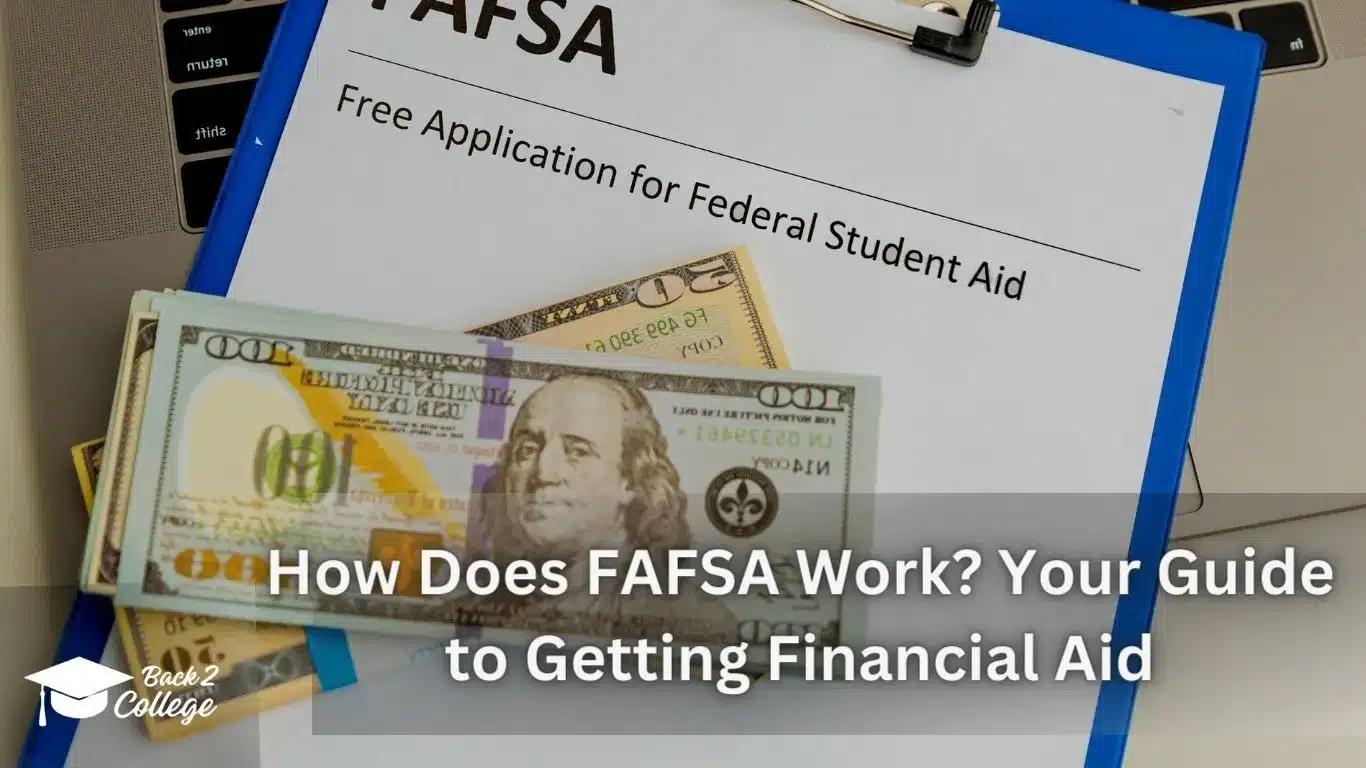In the pursuit of higher education, many students face one formidable hurdle which is the financial aspect of chasing their dreams.
In this realm, the Free Application for Federal Student Aid, commonly known as FAFSA, emerges as a beacon of hope, delivering a systematic approach while unlocking the door of financial assistance.
Consider Emily, a determined high school senior with the aspiration of attending a prestigious university to study computer science.
Although her parents are hardworking and supportive, they are worried about the financial strain that higher education might impose on the family. This is where the FAFSA steps in, offering a pathway for students.
However, in this guide, we will understand the workings of FAFSA. Plus, we will not only learn the technical aspects but also witness how this essential tool has changed the lives of countless students like Emily.
What is FAFSA?
The FAFSA or Free Application for Federal Student Aid is a form that is needed to be filled out by the students who want to apply for federal student aid which includes work-study funds, federal grants, and loans.
The U.S. Department of Education offers more than 120 billion dollars each year for approximately 13 million students in low interest loans, grants, and work-study funds through Federal Student Aid.
And to get these funds, students have to file the FAFSA form. The submission of FAFSA gives students access to the biggest source of aid that will help them pay for their career school, community college, college, or university.
How does FAFSA work?
For the U.S. Department of Education, FAFSA is like a determination tool to find out a student’s eligibility for financial support for college depending on their financial condition.
To figure out the eligibility, FAFSA demands a number of information regarding student’s and student’s parents’ income, investments and assets. They even ask about the number of kids in the household.
The paper version of the FAFSA is almost three times longer than the normal federal income tax form with over 100+ questions.
On the other hand, the online FAFSA presents pertinent questions using its skip-logic technology to the applicants.
After the students fill up the queries, a Student Aid Index (SAI) is produced and the Federal Government uses this information to determine how much financial support a student needs and which financial aid is perfect for the payment of college whether its non-need-based aid or need-based aid.
Even private scholarship programs, colleges, universities, and states highly depend on the information that students or their families provide in the FAFSA to find out the eligibility for further services.
However, here are some examples of the financial aid students may be offered by the government:
- Federal Pell Grants
- Federal Direct Subsidized Loans
- Federal Work-Study
- Federal Supplemental Educational Opportunity Grants (FSEOG)
- Direct Unsubsidized Loans
- TEACH or Teacher Education Access for College and Higher Education Grants
- Federal PLUS Loans
- State Based Financial Aid
- School-Based Financial Aid or School-Based Merit Aid
NB: The office of the Department of Education provides a Federal Student Aid Estimator for the students who aren’t ready to fill out the FAFSA in the first place. Students can get an estimate of their SIA and odds of getting financial aid by using this estimator easily.
How Does FAFSA Work for Grad School?
The FAFSA for grad school works very much identically to the FAFSA of undergraduate students.
But, there are 3 major differences between these two FAFSA:
Dependency Status
When applying for financial aid, graduate students are regarded as independent. That means students have to provide information about their own assets, income and investments. Their parents’ information will not be granted for the eligibility of financial aid.
Financial Assistance
Compared to undergraduate, graduate students have fewer loan and financial aid alternatives. As a graduate student, you can not apply for a subsidized loan.
Only direct unsubsidized and grad PLUS loans are available for grad school. As a result, students are solely liable for the interest on their loans.
Not only that, grad students are also not eligible for Pell grants. Yet, they may be offered other grant aid for their loan payment of college.
Borrowing Caps
For undergraduate students, there are annual and total borrowing caps for student loans.
On the other hand, Graduate students who are granted grad PLUS loans have no borrowing limits.
They can borrow the whole school-approved attendance costs from the loan servicers. However, unsubsidized loans for graduates have borrower limits.
Factors That Determine Financial Aid Eligibility
Students’ eligibility for financial aid depends on various factors. And these factors change depending on the aid type. Yet, the following factors are the general requirements that every student has to meet:
- Have to be a U.S. citizen or eligible noncitizen.
- Must be enrolled in an eligible certificate or degree program at a school or college.
- Must demonstrate financial necessity for most programs.
Remember, most students who apply for the FAFSA get some type of financial aid from the federal government. Plus, the eligibility does not depend on the following factor:
- The age of the student
- The tribe of the student
- The field where students want to study
How to fill Out The FAFSA?
Filling out the Free Application for Federal Student Aid (FAFSA) is an important step in the financial aid process for college.
Here’s a step-by-step guide on how to fill out the FAFSA:
Step 1- Create an FSA ID
Before you start the FAFSA, create a Federal Student Aid (FSA) ID at studentaid.gov for you and your mom or dad. This ID is used to sign the FAFSA electronically.
It may take a few days to activate your FSA ID, so it’s better you open your ID before a few days of the FAFSA fill up.
Step 2- Gather Necessary Documents
Collect all the documents regarding your FAFSA enrollment. Here are the information or documents that you need to collect for your FAFSA submission:
- Your Federal Student Aid (FSA) ID
- Social Security number or Alien Registration Number
- Account balances for your checking and savings accounts
- Info about investment accounts
- Federal income tax returns
- Records of untaxed income
If you are a dependent student, you will need similar information for your parents.
Step 3- Access the FAFSA
Go to the official FAFSA website . Be cautious of third-party websites. It is because they are mostly scams and charge fees for a service that is totally free.
Step 4- Start a New FAFSA
Click on “Start a New FAFSA.” You’ll be asked to enter your FSA ID and password to begin the process.
After entering, if you don’t understand anything, just click on the “?” symbol showing up by all queries.
After you click the “?” symbol, a new screen will open up and will have an explanation of what you need to do.
Step 5- Choose the Correct Year
Ensure that you are completing the FAFSA for the correct academic year. But it’s a tricky thing to do and most students make mistakes in this step. How?
Most students select the current year for their financial support. But all you have to do is to select the next year as you are requesting for financial aid for NEXT school year.
For instance, if you are applying for the FAFSA in the Fall of 2023 and you are a senior in the 2024 class, you have to fill out the 2024-25 FAFSA (not the 23-24 FAFSA).
Step 6- Create a Save Key
Create a Save Key, which is a password and it is not similar to your FSA ID. This password is only used for specific year’s FAFSA. So, remember it or write it down in your notes.
Step 7- Fill in Personal Information
Provide your personal information, including your name, date of birth, Social Security Number, citizenship status, state of residency, and contact information.
Step 8- Select School
List the schools you want your FAFSA information sent to. You can add up to 10 schools initially. In this step, you have to search for schools and select the school that matches your list.
Remember, school code is not important here, enter all the information accordingly in the boxes and further options will be brought up for your selection.
Step 9- Choose Dependency Status
Answer the dependency status questions to determine if you are considered a dependent or independent student. This affects whose information you need to provide.
In case you are an independent student, you will not be required to answer further questions about your parents. But if you are dependent, a new set of questions will appear regarding your parents’ job status and other stuff and you have to answer them.
Step 10- Provide Financial Information
Enter financial information, including income and tax information of yours or your parents (if dependent). Here, you may have The IRS Data Retrieval option to import your tax information directly and securely from the IRS if eligible.
Step 11- Sign and Submit
Now, in the submission page, you will face a question about if you are a preparer. Just answer no if your parents and you are filling out the FAFSA.
Then, both you and, if dependent, one parent must sign the FAFSA using their FSA IDs. After reviewing the information for accuracy, finally, submit the application.
Step 12- Confirmation
Once submitted, you’ll receive a confirmation page and email. Review these for any mistakes.
Check out this detailed guide to have a more precise idea about filling out the FAFSA for 2024.
What Happens After You Complete Your FAFSA?
After you successfully complete your FAFSA, several things happen in the process of determining your eligibility for financial aid:
1. First, you and your parents (if dependent) sign up will be confirmed by the U.S. Department of Education. This process will take around 7-10 days.
2. Once the process is complete, you will receive your Student Aid Report (SAR). The SAR summarizes the info you have provided in the FAFSA and indicates your Expected Family Contribution (EFC).
3. Then, all the information that you have provided in the FAFSA will be transferred to the State Student Achievement Council for the determination of your eligibility for state financial aid.
4. Plus, your selected colleges will receive your information securely and they will use this data to calculate the financial aid package.
5. After that, some students will be selected and asked to verify the accuracy of information. Also, if you are selected, you might need to submit additional documents like tax transcripts.
6. Once your college has processed everything, they will send you a financial aid award letter which includes the types (grants, scholarships, work-study, and federal student loans) and amounts of financial aid you are eligible to receive.
7. Finally, review the financial aid award letter and accept or decline it after being sure of the terms and conditions of each type of financial assistance.
Remember, during your college life, you need to fill up the FAFSA every year.
Deadline of FAFSA
The deadline for 20023-2024 FAFSA is on June 30, 2024 at 11:59 p.m. Central Time (CT). Also, the deadline can vary from state to state. So, you better take a look at the FAFSA deadline of your state.
And the new 2024-2025 school year FAFSA is anticipated to go live in December 2023 which is later than the unusual release date. Every year FAFSA releases on October 1.
What to do if you miss the deadline?
If you miss the deadline of the FAFSA, there is a high chance of not getting any aid for your financial support. But what can you do?
Well, submit your application as soon as possible if you miss the June 30 deadline.
Though you have applied for the FAFSA after the deadline, your application will still be considered if there is any leftover fund available after giving away money to all the applicants who have applied within the deadline.
Yet, the amount you receive may not satisfy you or fully fill your or your parents’ expectations as you have missed the deadline.
So, to get your expected aid amount, apply for FAFSA as soon as possible after the application process starts on October 1. Plus, be ready to do any corrections and resend it in no time.
To maximize your chances for financial aid, read this: Mistakes That Can Cost You Your Financial Aid
Some Programs That Need Filling Out FAFSA
When students apply for the FAFSA program, they basically apply for two types of financial aid. One is need-based and the other one is non-need based.
Now, here are some programs that include in these two types of financial aid and students need to fill up the FAFSA, if they want to get one:
Need-Based Financial Aid
Pell Grants
Any type of grant does not require repayment, that’s why students with exceptional financial need apply for this. And among all the grants, Pell Grants are the primary federal grants for college.
Undergraduate students who are extremely non-privileged are offered Pell Grants by the federal government. However, there are some teacher certification programs which are eligible for Pell Grants.
According to the 2023–2024 Federal Student Aid Handbook, for the 2024-2025 award year( July 1, 2024, to June 30,2025), applicants will be awarded up to $7,395 as Pell Grants.
Direct Subsidized Loans
Government subsidizes these loans. As a result, students don’t have to pay interest while in school or for a six-month grace period after graduation.
These loan amounts range from $3500 to $12500 per year for non-graduate students and the amount of the direct subsidized loans depends on the students’ school year and dependency status.
Federal Supplemental Education Opportunity Grants (FSEOG)
FSEOG is available at select schools, so students must do research while listing their desirable college. Just like Pell Grants, these grants also don’t require any repayment. They range from $100 to $4000 annually and are designed for students with limited financial resources.
Federal Work-Study
In this financial aid, students are provided with a paid part-time job through their joining to the universities and colleges by the federal government. Not only graduate but undergrad students are also suitable for the federal work-study programs.
Non-Need Based Financial Aid
Federal Plus Loans
PLUS loans are available for graduate students or their parents. And, the government does not fund them. So, any interest accumulated throughout the college years will be affixed to the principal if students did not pay it during their enrollment in the class.
Direct Unsubsidized Loans
Direct unsubsidized loans are different from subsidized loans. Whereas direct subsidized loans do not require repayment of the interest, unsubsidized loans require interest payment as the government doesn’t subsidize them.
Plus, your or your parents’ failure to pay the interest in time will cause an add up to the principal of the loan.
However, dependent students can get an amount up to $31,000 over their undergraduate academic years in unsubsidized and subsidized loans if their parents are not qualified for federal PlUS loans.
Teacher Education Access for College and higher education (TEACH) Grants
According to Federal Student Aid, students will receive up to $4000 per year as TEACH grants if they are getting trained to become teachers.
But there are certain requirements for these grants. And if you don’t fully fill the requirements, this grant will convert into direct unsubsidized loans.
Here is what students have to do for the qualification of the TEACH grants:
- Must attend particular classes that are only for the qualification of TEACH grants.
- Must work in secondary school or elementary school or educational agency for at least 4 years who gives services to low-income families.
FAQ
Is FAFSA a loan or grant?
FAFSA is not a grant or loan. It is an application form which is used to apply for federal loans and financial aid. These financial aids may include student employment, several types of grants and federal student loans.
How do you calculate expected family contribution?
The contribution from assets and available income made by you and your spouse is added to determine your EFC, which is then divided by the number of years in college. However, you can use a simple method. Try the EFC calculator to find out your expected family contribution.
Do you have to pay back financial aid?
Your pay back of financial aid depends on what type of aid you have been granted. If it is a loan then you have to pay it back with the interest. But you don’t have to pay back scholarships, grants, or awarded money throughout a federal work-study program.
How does financial aid work per semester?
Financial aid is given to the students typically for one academic year which covers two semesters. The aid is disbursed in two equal amounts- one for each semester. This financial aid will cover up your tuition, fees, and other educational expenses for one year. However, if you have work-study, you will earn wages throughout the semester. For further and en-detailed info do contact the financial aid office of your school or college.
How does FAFSA pay you?
The U.S. Department of Education sends your information to your listed school once they process your FAFSA. Then, the school will pay out the money to you after the federal government grants you financial aid in at least two payments which are called disbursements.
Still have questions? Then read this: Financial Aid: Frequently Asked Questions
Final Thoughts: Understanding the 2023–24 FAFSA
That’s all for today. The FAFSA is an amazing opportunity for financially non-privileged students which evaluates eligibility for manifold financial aid options during a student’s higher study.
Hopefully, this comprehensive guide has provided all the necessary information and guidelines regarding how the whole FAFSA process works.
However, students’ ongoing vigilance, timely responsiveness, and maintenance of academic standards are compulsory for the smooth flow of the financial assistance throughout the academic year.
Sources
- The FAFSA Simplification Act (2022 August) by Congressional Research Service
- FAFSA Simplification Act Changes for Implementation 2024-25 By Federal Student Aid
- FAFSA Deadlines by Federal Student Aid
- What is the FAFSA? An adult learner knowledge survey of student financial aid jargon (January 24, 2019) by ZW Taylor and Ibrahim Bicak













